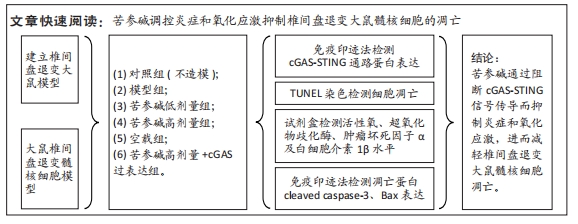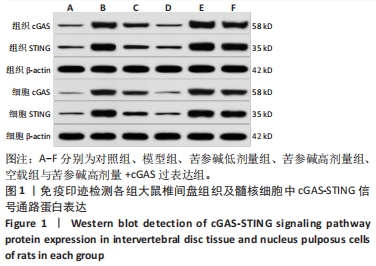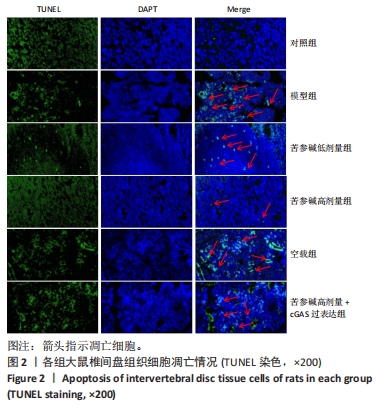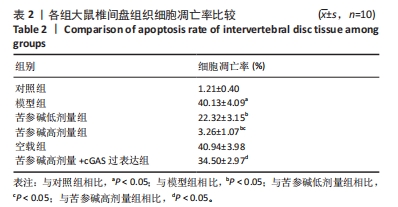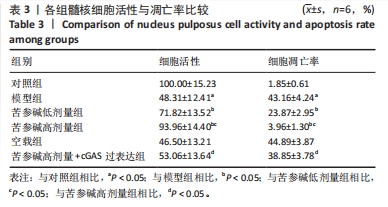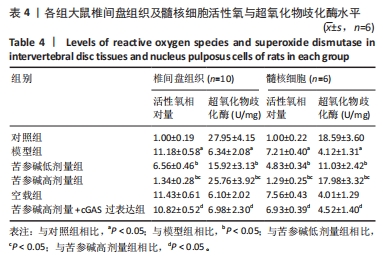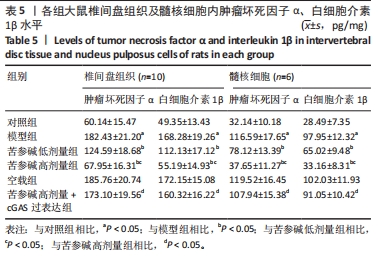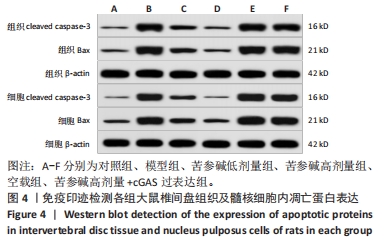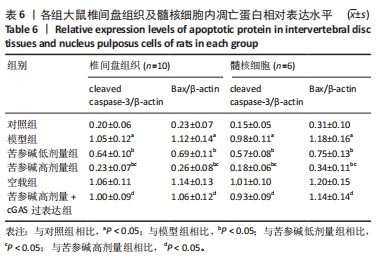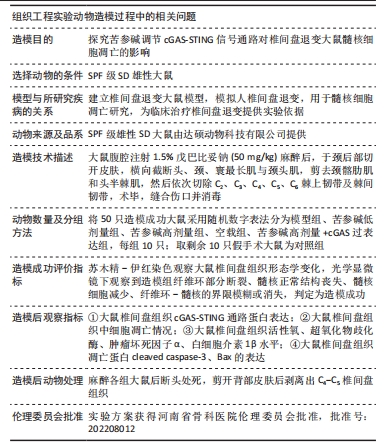[1] LI L, HE J, ZHANG G, et al. Role of Caspase Family in Intervertebral Disc Degeneration and Its Therapeutic Prospects. Biomolecules. 2022;12(8):1074-1094.
[2] HU YC, ZHANG XB, LIN MQ, et al. Nanoscale Treatment of Intervertebral Disc Degeneration: Mesenchymal Stem Cell Exosome Transplantation. Curr Stem Cell Res Ther. 2023;18(2):163-173.
[3] CHENG H, GUO Q, ZHAO H, et al. An Injectable Hydrogel Scaffold Loaded with Dual-Drug/Sustained-Release PLGA Microspheres for the Regulation of Macrophage Polarization in the Treatment of Intervertebral Disc Degeneration. Int J Mol Sci. 2022;24(1):390-411.
[4] WANG DK, ZHENG HL, ZHOU WS, et al. Mitochondrial Dysfunction in Oxidative Stress-Mediated Intervertebral Disc Degeneration. Orthop Surg. 2022;14(8): 1569-1582.
[5] XIE X, MA G, LI X, et al. Activation of innate immune cGAS-STING pathway contributes to Alzheimer’s pathogenesis in 5×FAD mice. Nat Aging. 2023;3(2):202-212.
[6] GULEN MF, SAMSON N, KELLER A, et al. cGAS-STING drives ageing-related inflammation and neurodegeneration. Nature. 2023;620(7973):374-380.
[7] REN C, JIN J, LI C, et al. Metformin inactivates the cGAS-STING pathway through autophagy and suppresses senescence in nucleus pulposus cells. J Cell Sci. 2022; 135(15):jcs259738.
[8] ZHANG W, LI G, LUO R, et al. Cytosolic escape of mitochondrial DNA triggers cGAS-STING-NLRP3 axis-dependent nucleus pulposus cell pyroptosis. Exp Mol Med. 2022;54(2):129-142.
[9] GUO Q, ZHU D, WANG Y, et al. Targeting STING attenuates ROS induced intervertebral disc degeneration. Osteoarthritis Cartilage. 2021;29(8):1213-1224.
[10] YUAN L, YANG J, LI Y, et al. Matrine alleviates cisplatin-induced acute kidney injury by inhibiting mitochondrial dysfunction and inflammation via SIRT3/OPA1 pathway. J Cell Mol Med. 2022;26(13):3702-3715.
[11] LU Q, LIN X, WU J, et al. Matrine attenuates cardiomyocyte ischemia-reperfusion injury through activating AMPK/Sirt3 signaling pathway. J Recept Signal Transduct Res. 2021;41(5):488-493.
[12] 陈棪.氧化苦参碱通过TLR4/NF-κB信号通路抑制IL-1β诱导的髓核细胞和细胞外基质降解[D].武汉:华中科技大学,2019.
[13] 刘志刚,郭庆功,陈景涛.刺山柑总生物碱干预椎间盘退变模型大鼠髓核细胞的增殖与凋亡[J].中国组织工程研究,2021,25(11):1699-1904.
[14] 仇湘中,刘栋,张信成,等.补肝健腰方对腰椎间盘退变大鼠椎间盘MMP-3、TIMP-1表达的影响[J].北京中医药大学学报,2017,40(11):940-945.
[15] 周婷婷,杨文广,胡艳婷,等.基于Toll样受体4/核因子κB信号通路探究苦参碱对类风湿关节炎风湿热痹证的治疗作用及机制[J].中医正骨,2022, 34(10):1-9.
[16] 康小彪,李鹏飞,滕元平,等.淫羊藿苷通过核转录因子KappaB通路减轻大鼠椎间盘退变[J].广州中医药大学学报,2022,39(8):1878-1885.
[17] 范锲,李文浩,陈锋,等.Mfn2通过抑制内质网应激减轻椎间盘退变大鼠髓核细胞凋亡[J].医学研究杂志,2022,51(8):104-109.
[18] LI B, YANG X, ZHANG P, et al. Engeletin Alleviates the Inflammation and Apoptosis in Intervertebral Disc Degeneration via Inhibiting the NF-κB and MAPK Pathways. J Inflamm Res. 2022;15:5767-5783.
[19] HE S, FU Y, YAN B, et al. Curcumol Alleviates the Inflammation of Nucleus Pulposus Cells via the PI3K/Akt/NF-κB Signaling Pathway and Delays Intervertebral Disk Degeneration. World Neurosurg. 2021;155:e402-e411.
[20] LIU MY, ZHANG L, ZANG WD, et al. Pharmacological Effects of Resveratrol in Intervertebral Disc Degeneration: A Literature Review. Orthop Surg. 2022;14(12): 3141-3149.
[21] CHEN J, YANG X, FENG Y, et al. Targeting Ferroptosis Holds Potential for Intervertebral Disc Degeneration Therapy. Cells. 2022;11(21):3508-3519.
[22] SAMANTA A, LUFKIN T, KRAUS P. Intervertebral disc degeneration-Current therapeutic options and challenges. Front Public Health. 2023;11:1156749.
[23] BINCH ALA, FITZGERALD JC, GROWNEY EA, et al. Cell-based strategies for IVD repair: clinical progress and translational obstacles. Nat Rev Rheumatol. 2021; 17(3):158-175.
[24] TANG H, ZHANG S, LU X, et al. Effects of puerarin on the intervertebral disc degeneration and biological characteristics of nucleus pulposus cells. Pharm Biol. 2023;61(1):12-22.
[25] KRUT Z, PELLED G, GAZIT D, et al. Stem Cells and Exosomes: New Therapies for Intervertebral Disc Degeneration. Cells. 2021;10(9):2241.
[26] SWAMY G, SALO P, DUNCAN N, et al. IL-1Ra deficiency accelerates intervertebral disc degeneration in C57BL6J mice. JOR Spine. 2022;5(2):e1201.
[27] LIANG H, SHI H, LI Y, et al. Mechanism of Aspirin oxidative stress regulating interleukin-induced apoptosis in nucleus pulposus cells in a rat model of intervertebral disc degeneration. Ann Transl Med. 2023;11(2):124.
[28] TIAN X, ZHANG Y, SHEN L, et al. Kartogenin-enhanced dynamic hydrogel ameliorates intervertebral disc degeneration via restoration of local redox homeostasis. J Orthop Translat. 2023;42:15-30.
[29] DANIELS J, BINCH AA, LE MAITRE CL. Inhibiting IL-1 signaling pathways to inhibit catabolic processes in disc degeneration. J Orthop Res. 2017;35(1):74-85.
[30] XIANG Q, ZHAO Y, LIN J, et al. The Nrf2 antioxidant defense system in intervertebral disc degeneration: Molecular insights. Exp Mol Med. 2022;54(8):1067-1075.
[31] MOHD ISA IL, TEOH SL, MOHD NOR NH, et al. Discogenic Low Back Pain: Anatomy, Pathophysiology and Treatments of Intervertebral Disc Degeneration. Int J Mol Sci. 2022;24(1):208.
[32] SILWAL P, NGUYEN-THAI AM, MOHAMMAD HA, et al. Cellular Senescence in Intervertebral Disc Aging and Degeneration: Molecular Mechanisms and Potential Therapeutic Opportunities. Biomolecules. 2023;13(4):686.
[33] CHEN A, FANG D, REN Y, et al. Matrine protects colon mucosal epithelial cells against inflammation and apoptosis via the Janus kinase 2 /signal transducer and activator of transcription 3 pathway. Bioengineered. 2022;13(3):6490-6499.
[34] KANG J, LIU S, SONG Y, et al. Matrine treatment reduces retinal ganglion cell apoptosis in experimental optic neuritis. Sci Rep. 2021;11(1):9520-9531.
[35] DECOUT A, KATZ JD, VENKATRAMAN S, et al. The cGAS-STING pathway as a therapeutic target in inflammatory diseases. Nat Rev Immunol. 2021;21(9):548-569.
[36] GAO Z, GAO Z, ZHANG H, et al. Targeting STING: From antiviral immunity to treat osteoporosis. Front Immunol. 2023;13:1095577.
[37] SCHUSTAK J, TWAROG M, WU X, et al. Mechanism of Nucleic Acid Sensing in Retinal Pigment Epithelium (RPE): RIG-I Mediates Type I Interferon Response in Human RPE. J Immunol Res. 2021;2021:9975628.
[38] LI J, SUN X, YANG N, et al. Phosphoglycerate mutase 5 initiates inflammation in acute kidney injury by triggering mitochondrial DNA release by dephosphorylating the pro-apoptotic protein Bax. Kidney Int. 2023;103(1):115-133.
[39] YAN M, LI Y, LUO Q, et al. Mitochondrial damage and activation of the cytosolic DNA sensor cGAS-STING pathway lead to cardiac pyroptosis and hypertrophy in diabetic cardiomyopathy mice. Cell Death Discov. 2022;8(1):258-269.
[40] SU Q, CAI Q, LI Y, et al. A novel rat model of vertebral inflammation-induced intervertebral disc degeneration mediated by activating cGAS/STING molecular pathway. J Cell Mol Med. 2021;25(20):9567-9585.
|
